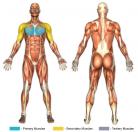Standing Crossover Flys (Cable)
- Attach the single-grip cable attachments and ensure that they are set in the high position.
- Grab the attachments and stand with legs about shoulder width apart or less (whether the legs are side by side or one in front of the other is a matter of preference).
- Depending on the chosen weight, it may be difficult to get into the proper starting position. Normally, if the weight is particularly heavy, rowing the grip in towards the torso and then down so that the weight is directly under the downward pointing arms will be an effective way to get into the proper starting position.
- Once the weight is under the arms, lean the torso forward slightly (enough to find proper balance with the chosen weight).
- Carefully move the arms out to the sides (being sure to keep, at minimum, a slight bend in the arms at all times), while inhaling throughout the movement.
- Once a nice (but comfortable) stretch is felt, squeeze the arms together until they cross one another, exhaling throughout the movement. It is at this time that the inner chest (sternal head) is most optimally contracted. It is recommended that the hand on top is alternated each repetition for most identical muscular recruitment of each pectoral muscle.
- Repeat steps 5-6 for as many repetitions as are desired.
As noted above, the crossed-arm motion is where the inner chest (sternal head) is most optimally contracted. If the goal is to work the inner aspect of the chest, then pay extra attention to the squeeze at the very end of the positive motion (where the arms have crossed).
The fully-stretched, lower aspect of the motion is where the outer chest is most optimally contracted. If the goal is to work the outer aspect of the chest, then pay extra attention to the stretch at the very end of the negative motion (where the arms are low).
Crossing the cables low, near the abdomen, will recruit more of the lower aspect of the chest. See Bent-Forward Crossovers (Cable).
Cable crossover flys work the pectoralis minor muscles, in addition to the primary pectoralis major muscles. The pectoralis minor lie beneath the pectoralis major, and run somewhat vertically from the upper aspect of the chest (near the supraspinatus tendon) to connect at several lower ribs in the chest. The purpose of the pectoralis minor are to stabilize the shoulder blade (scapula), and to pull it forward.
The very end of the negative motion (when the arms are outstretched to the sides) is conventionally considered a hazardous aspect of any sort of fly exercise and this is no different for crossover flys. When the arms are outstretched to the sides, tremendous stress is put on the shoulders. Especially with heavy weight usage. Biceps injuries, though far less common, do also occur with flys. As a general rule, if not familiar with flys or if pain is felt, use good judgment and only use weight amounts that you are comfortable with.





